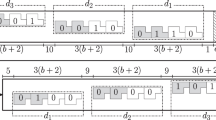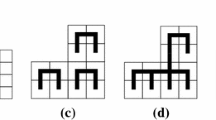Abstract
We study the problem of determining the size of the smallest tile set that uniquely self-assembles into a given target shape in Winfree’s abstract Tile Assembly Model (aTAM), an elegant theoretical model of DNA tile self-assembly. This problem is also known as the “directed tile complexity” problem. We prove two main results related to the directed tile complexity problem within a variant of the aTAM in which the minimum binding strength threshold (temperature) is set to 1. For our first result, self-assembly happens in a “just-barely 3D” setting, where self-assembling unit cubes are allowed to be placed in the \(z=0\) and \(z=1\) planes. This is the same setting in which Furcy, Summers and Withers (DNA 2021) recently proved lower and upper bounds on the directed tile complexity of a just-barely 3D \(k \times N\) rectangle at temperature 1 of \(\Omega \left( N^{\frac{1}{k}}\right) \) and \(O\left( N^{\frac{1}{k-1}}+\log N\right) \), respectively, the latter of which does not hold for \(k=2\). Our first result closes this gap for \(k=2\) by proving an asymptotically tight bound of \(\Theta (N)\) on the directed tile complexity of a just-barely 3D \(2 \times N\) rectangle at temperature 1. Our proof uses a novel process by which a just-barely 3D assembly sequence is “unfolded” to an equivalent 2D assembly sequence. For our second result, we use the aforementioned lower bound by Furcy, Summers and Withers and a novel process that is complementary-in-spirit to our 3D-to-2D unfolding process, by which we “fold” a 2D tile assembly to an equivalent just-barely 3D assembly to prove a new lower bound on the directed tile complexity of a 2D \(k \times N\) rectangle at temperature 1 of \(\Omega \left( \frac{N^{\frac{2}{k + (k \bmod 2)}}}{k} \right) \). For fixed k, our new bound gives a nearly quadratic improvement over, and matches for general even values of \(k < \frac{\log N}{\log \log N - \log \log \log N}\) the state of the art lower bound on the directed tile complexity of a \(k \times N\) rectangle at temperature 1 by Furcy, Summers and Wendlandt (DNA 2019) of \(\Omega \left( N^{\frac{1}{k}}\right) \). While both of our results represent improvements over previous corresponding state of the art results, the proofs thereof are facilitated by novel examples of reasoning about tile self-assembly happening in 2D (just-barely 3D) as though it is happening in just-barely 3D (2D).








Similar content being viewed by others
Availability of data and materials
Not applicable.
Notes
A cut-set is a subset of edges in a graph which, when removed from the graph, produces two or more disconnected subgraphs. The weight of a cut-set is the sum of the weights of all of the edges in the cut-set.
This is a

because, at this location, both paths come together again.
References
Adleman LM, Cheng Q, Goel A, et al (2001) Running time and program size for self-assembled squares. In: Proceedings of the thirty-third annual ACM symposium on theory of computing (STOC), pp 740–748
Aggarwal G, Cheng Q, Goldwasser MH et al (2005) Complexities for generalized models of self-assembly. SIAM J Comput (SICOMP) 34:1493–1515
Cook M, Fu Y, Schweller RT (2011) Temperature 1 self-assembly: deterministic assembly in 3D and probabilistic assembly in 2D. In: Proceedings of the twenty-second annual ACM-SIAM symposium on discrete algorithms (SODA), pp 570–589
Furcy D, Summers SM, Wendlandt C (2019) New bounds on the tile complexity of thin rectangles at temperature-1. In: DNA Computing and molecular programming—25th international conference, DNA 25, Seattle, WA, USA, 5–9 Aug 2019, Proceedings, Lecture Notes in Computer Science, vol 11648. Springer, pp 100–119
Furcy D, Summers SM, Withers L (2021) Improved lower and upper bounds on the tile complexity of uniquely self-assembling a thin rectangle non-cooperatively in 3d. In: 27th International conference on DNA computing and molecular programming, DNA 27, 13–16 Sept 2021, Oxford, UK (Virtual Conference), LIPIcs, vol 205. Schloss Dagstuhl - Leibniz-Zentrum für Informatik, pp 4:1–4:18
Jordan C (1887) Cours d’analyse, pp 587–594
Manuch J, Stacho L, Stoll C (2010) Two lower bounds for self-assemblies at temperature 1. J Comput Biol 17(6):841–852
Meunier PE, Patitz MJ, Summers SM, et al (2014) Intrinsic universality in tile self-assembly requires cooperation. In: Proceedings of the twenty-fifth annual ACM-SIAM symposium on discrete algorithms (SODA), pp 752–771
Rothemund PWK (2001) Theory and experiments in algorithmic self-assembly. PhD thesis, University of Southern California
Rothemund PWK, Winfree E (2000) The program-size complexity of self-assembled squares (extended abstract). In: The thirty-second annual ACM symposium on theory of computing (STOC), pp 459–468
Seeman NC (1982) Nucleic-acid junctions and lattices. J Theor Biol 99:237–247
Soloveichik D, Winfree E (2007) Complexity of self-assembled shapes. SIAM J Comput (SICOMP) 36(6):1544–1569
Winfree E (1998) Algorithmic self-assembly of DNA. PhD thesis, California Institute of Technology
Acknowledgements
This work was supported in part by University of Wisconsin Oshkosh Research Sabbatical (S581) during Fall 2023.
Funding
This work was supported in part by University of Wisconsin Oshkosh Research Sabbatical (S581) during Fall 2023.
Author information
Authors and Affiliations
Contributions
All authors contributed equally.
Corresponding author
Ethics declarations
Conflict of interest
Not applicable.
Ethical approval
Not applicable.
Additional information
Publisher's Note
Springer Nature remains neutral with regard to jurisdictional claims in published maps and institutional affiliations.
Rights and permissions
Springer Nature or its licensor (e.g. a society or other partner) holds exclusive rights to this article under a publishing agreement with the author(s) or other rightsholder(s); author self-archiving of the accepted manuscript version of this article is solely governed by the terms of such publishing agreement and applicable law.
About this article
Cite this article
Furcy, D., Summers, S.M. & Vadnais, H. Proving new directed tile complexity lower bounds at temperature 1 by folding between 2D and just-barely 3D self-assembly. Nat Comput (2024). https://doi.org/10.1007/s11047-024-09979-0
Accepted:
Published:
DOI: https://doi.org/10.1007/s11047-024-09979-0





